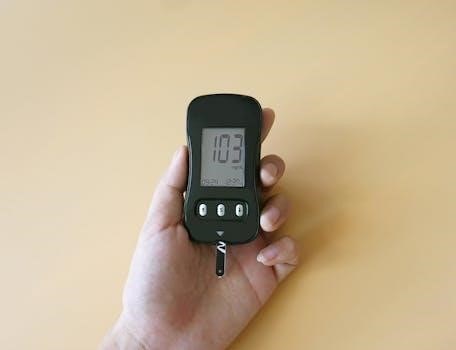The Blood Pressure Program utilizes specific exercises to reduce stress‚ a key factor in elevated blood pressure. This program‚ detailed in a PDF guide‚ offers simple‚ focused movements designed to stabilize blood pressure levels.
Understanding the Need for Exercise in Managing Blood Pressure
Engaging in regular physical activity is a cornerstone of managing blood pressure effectively. Exercise provides a natural‚ medicine-free approach to lowering blood pressure‚ offering benefits that extend beyond just physical health. It strengthens the heart‚ making it more efficient at pumping blood‚ which in turn reduces the pressure on artery walls. Moreover‚ exercise helps in weight management‚ further contributing to healthier blood pressure levels. Consistent activity promotes overall cardiovascular health‚ reducing the risk of heart disease and stroke‚ conditions often associated with hypertension. This approach isn’t just for those with high blood pressure; it is beneficial for everyone‚ regardless of their current blood pressure levels‚ promoting long-term well-being by decreasing mortality risk.

Types of Exercises for Blood Pressure Control

Effective blood pressure management involves various exercise types‚ including aerobic‚ strength training‚ and isometric exercises. Each offers unique benefits to help regulate blood pressure.
Aerobic Exercises and Their Impact on Blood Pressure
Aerobic exercises‚ involving rhythmic and repetitive movements of large muscle groups‚ are highly recommended for managing blood pressure. Activities like brisk walking‚ running‚ cycling‚ and swimming are considered beneficial. These exercises improve cardiovascular health‚ leading to a reduction in blood pressure over time. Engaging in moderate-intensity aerobic activity for at least 150 minutes per week is advised. The consistent engagement of large muscles during aerobic workouts helps to strengthen the heart‚ making it more efficient in pumping blood‚ thus lowering overall blood pressure. This type of exercise is a cornerstone in many blood pressure management programs‚ offering a natural way to reduce hypertension. Regular aerobic activity can significantly impact long-term cardiovascular health.
Strength Training and Its Benefits for Hypertension
While traditionally aerobic exercises are highlighted‚ strength training also plays a crucial role in managing hypertension. Engaging in strength training activities‚ whether using weights or body resistance‚ contributes to improved cardiovascular health. This form of exercise helps to strengthen the heart‚ making it more efficient and thus lowering blood pressure. It’s recommended to incorporate strength training 2 to 3 times per week‚ as per guidelines. The benefits of strength training extend beyond muscle development; it also aids in better blood flow and overall vascular health. Unlike aerobic exercises‚ strength training involves targeted muscle engagement which‚ when done consistently‚ can lead to a healthier blood pressure profile. It’s a vital component of a comprehensive approach to hypertension management.
Isometric Exercises⁚ An Effective Tool for Lowering Blood Pressure
Recent research highlights isometric exercises‚ which involve muscle engagement without movement‚ as a valuable method for controlling blood pressure. Activities like wall squats and planks are examples of isometric exercises that can effectively lower blood pressure. These exercises‚ by engaging muscles without dynamic motion‚ provide a unique way to improve vascular function and reduce hypertension; Studies suggest that regular incorporation of isometric exercises into a fitness routine can lead to significant reductions in blood pressure; They are particularly beneficial because they can be done at home with minimal equipment. Isometric exercises offer a convenient and effective approach to managing hypertension‚ complementing other forms of physical activity. Including these in your exercise plan is a wise choice for blood pressure control.
Specific Exercises for Blood Pressure Management
This section details effective exercises for managing hypertension‚ including isometric‚ aerobic‚ and strength training options. These targeted activities are designed to help lower blood pressure naturally.
Examples of Effective Isometric Exercises
Isometric exercises‚ which involve muscle engagement without movement‚ are proving to be a valuable tool in managing blood pressure. These exercises‚ such as wall squats‚ planks‚ and bridges‚ can be easily incorporated into a daily routine. Holding a plank‚ for instance‚ engages multiple muscle groups simultaneously‚ leading to positive effects on blood pressure. Similarly‚ wall sits‚ where you maintain a seated position against a wall‚ can be an effective isometric exercise. Bridges‚ another example‚ work the core and gluteal muscles. These simple yet powerful exercises contribute significantly to lowering blood pressure. Recent studies suggest these types of exercises are a great option for those with hypertension‚ making them a valuable part of the blood pressure program‚ and they can be done at home. Remember‚ consistency is key when using these exercises for blood pressure control.

Recommended Aerobic Activities for Hypertension
Aerobic exercises‚ which involve rhythmic and repetitive movement of large muscle groups‚ are highly recommended for managing hypertension. Activities like brisk walking‚ running‚ cycling‚ and swimming are excellent choices. These exercises help improve cardiovascular health and lower blood pressure over time. It is advised to incorporate these activities for 3-6 days per week at a moderate intensity. Aim for at least 150 minutes of moderate-intensity aerobic exercise per week to gain the maximum benefit. Remember to choose activities that you enjoy and can maintain consistently‚ like hiking or dancing. Engaging in these activities regularly can lead to a significant reduction in blood pressure and reduce the risk of heart disease. It is important to consult with your healthcare provider before starting any new exercise program.
Strength Training Exercises to Include in a Program
While aerobic exercises are crucial‚ incorporating strength training is also beneficial for managing hypertension. Strength training helps build muscle‚ which can aid in lowering blood pressure. Include exercises such as squats‚ lunges‚ and push-ups‚ focusing on proper form and controlled movements. It is recommended to engage in resistance training 2 to 3 times per week. Remember to avoid holding your breath during these exercises‚ as this can cause a sudden spike in blood pressure. Start with lighter weights or resistance and gradually increase as you get stronger. Consult with a fitness professional for guidance on the correct techniques. Combining strength training with aerobic exercises can lead to a more comprehensive approach to lowering blood pressure and improving overall health. This approach can be beneficial for people with hypertension.
Implementing an Exercise Program
To effectively implement an exercise program‚ start gradually‚ focusing on consistency. Monitor your body’s response‚ and be aware of any precautions. This approach will ensure a safe and beneficial experience.
Frequency and Intensity of Exercises
For optimal blood pressure management‚ aim for moderate-intensity aerobic activity most days of the week‚ ideally five to seven days. The American College of Sports Medicine (ACSM) recommends at least 150 minutes weekly. Strength training should be incorporated two to three times per week. Intensity should be moderate‚ allowing for conversation during exercise. Avoid overexertion‚ especially if you have high blood pressure over 160/100mmHg. Consistency is key‚ and gradually increasing both frequency and intensity is advisable. Listen to your body‚ and consult with a healthcare professional before starting a new exercise regimen‚ particularly if you have existing health conditions. Remember that regular physical activity‚ even at lower intensity‚ can benefit your health.
Important Precautions During Exercise
It’s crucial to take precautions when exercising to manage blood pressure. Avoid strenuous activity if your blood pressure is above 160/100mmHg. Don’t hold your breath during resistance exercises‚ as this can cause a sudden spike in blood pressure. If using hot tubs or saunas‚ be cautious‚ especially with high blood pressure; avoid rapid temperature changes between cold water and hot environments. Refrain from consuming alcohol when using saunas‚ as it’s a dangerous combination. Stay well-hydrated and monitor your body’s responses during exercise. If you experience dizziness or chest pain‚ stop immediately and consult a healthcare professional. It is essential to listen to your body and never push beyond your limits. Consider using a physical activity log to track your progress.

Resources and Guidelines
The American College of Sports Medicine (ACSM) provides essential guidelines for physical activity. Their resources help integrate exercise into clinical care‚ promoting evidence-based approaches for blood pressure management.
The Role of the American College of Sports Medicine (ACSM)
The American College of Sports Medicine (ACSM) plays a pivotal role in promoting physical activity as a standard component of healthcare. With over 45‚000 members‚ the ACSM is dedicated to enhancing lives through movement. Their global initiative‚ Exercise is Medicine (EIM)‚ emphasizes the importance of physical activity assessment and promotion within clinical settings. The ACSM provides evidence-based resources‚ ensuring that people have access to effective exercise programs for managing blood pressure. Their guidelines‚ which recommend moderate-intensity aerobic training most days of the week and resistance training a few times a week‚ serve as a benchmark for healthcare professionals and individuals seeking to improve their health through exercise. The ACSM’s work connects healthcare professionals with the necessary tools and information to integrate physical activity into their patients’ care plans‚ fostering a healthier community.



Leave a Reply
You must be logged in to post a comment.